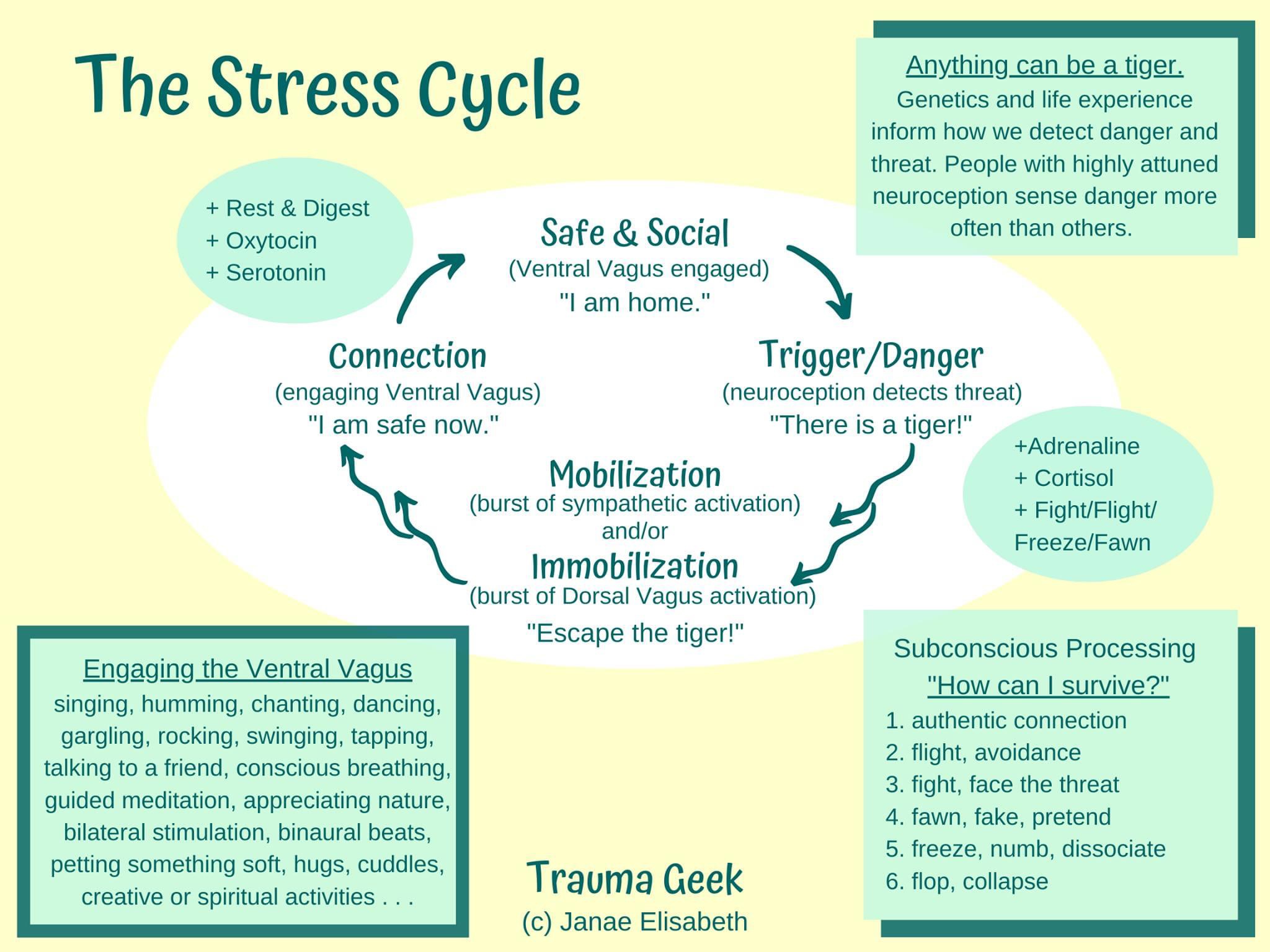Everyone gets stressed, triggered or upset sometimes – especially in these calamitous times.
There are moments, though, when what you’re feeling seems worse than a typical upset and starts veering into crisis territory. If you feel your face getting hot, your blood boiling or your chest getting tight and panicky, it may be a good idea to take a time-out to calm and settle your raging nervous system.
According to polyvagal theory, the vagus nerve in our nervous system helps to shape our stress, safety and social responses. Our nervous system is constantly scanning for cues of danger or safety, and often our body reacts before our thoughts can catch up to reassure us that there’s no tiger (or other danger) present.
Since feeling safe is the foundation for healing, connection and executive function, it is crucial to regulate our nervous system if it starts to overreact unnecessarily. This is an especially important skill for those with a highly-sensitive nervous system which may be hyper-attuned to sensing or seeing tigers.
Regulating the nervous system often happens through body-based or somatic practices, not just cognitive ones. In other words, sometimes you have to do something physical, not just talk or think things through, to feel truly safe and calm.
Through my own personal experiences and training and more than three years of working with young people in crisis, plus lots of research, reading and watching videos, I’ve amassed a collection of 20 body hacks to help quickly rein in an anxious nervous system and instill a sense of calm and reassurance.
I hope you’ll find these helpful! Remember that everybody (and every body) is different, so try a few or more before you decide these body-based techniques don’t work for you.
- Deep breathing, soft belly breathing, box or 4-7-8 breathing. While many people get annoyed when breathing is suggested, it’s the gold standard for calming bodies and brains because it truly does work. Long, slow, deep breaths are the key.
- Try the physiological sigh: take two sharp, quick breaths in, then blow the air out in one long, sighing exhale. This is pretty handy and can be done when standing in line, driving in a car or just about anytime.
- Put your index fingers just inside your ears and gently pull down toward your shoulders. Some people find this soothing, while others find it annoying, but supposedly it relaxes the vagus nerve which can help calm the nervous system.
- Get weighed down by a heavy blanket or weighted stuffy. This can be very comforting for a lot of people – and even dogs, if you’ve ever seen the snug-fitting “thunder shirts” that some dogs wear during storms to help them stay calm.
- Self-swaddle with a hoodie. There’s a technique where you put a hoodie on but leave your arms out of the sleeves and then have someone tie the empty sleeves tightly around you, straightjacket-style. This can be very comforting and calming. If you don’t have someone to help, you can also just do a self-hug or tightly wrap your arms around yourself.
- The butterfly hug. Cross your arms over your chest and alternate gently tapping your left and right arms.
- Somatic tapping. Keep that gentle rhythmic tapping going, and move to chest, arms, face and legs.
- Cold air or cold water on the face/forehead – also try drinking an ice-cold glass of water.
- Swinging. There’s a reason so many of us love to swing from a young age – it can be very calming! Swings are great to have for anyone who experiences anxiety or panic.
- Swaying or rocking side to side. Like swinging, this type of vestibular engagement can soothe the nervous system.
- Humming or singing softly. It’s nearly impossible to be angry or stressed while humming or singing. Try it!
- Shaking or bouncing. Maybe T-Swift was onto something with “Shake it Off” – it really can help soothe our nervous systems.
- Small, intentional eye movements (look behind, toward doors or windows, in front, in back, left & right, up & down). This gives the body reassurance that there is no danger lurking to harm us.
- Vocalize, scream or sing out loud! Loudly vocalizing can be a coping mechanism for many people. If you can’t make a lot of noise where you live, try doing it into a soft pillow.
- Bilateral stimulation such as alternating index finger pointing and thumbs up. This is hard enough to do that it takes you out of your head and distracts you into feeling calm. It takes a fair amount of coordination! Start slow and then work your way up to going faster.
- Grounding through contact. Push your feet into the floor or press your palms together. Focus on how it feels.
- Vagus nerve stimulation via gentle touch. Lightly stroke down the sides of your neck, or place a warm hand on your chest or over your heart.
- “Havening” touch. Give yourself slow strokes down the arms from shoulder to elbow. You can watch videos of how to do this for yourself or others.
- Warmth: holding your hand over your heart, using a heating pad or having a warm drink can be very soothing and calming.
- Grounding exercises such as naming one thing you can feel or sense in the moment – or one of my favorites, 5-4-3-2-1 grounding.
I feel calmer just writing about these wonderful tricks and techniques. If you know of other great body hacks to help an agitated nervous system feel safe, please let me know in the comments below or over on Facebook or Instagram. I’m always adding to my collection as I learn more!
What’s your favorite way to get back to feeling safe and calm?




